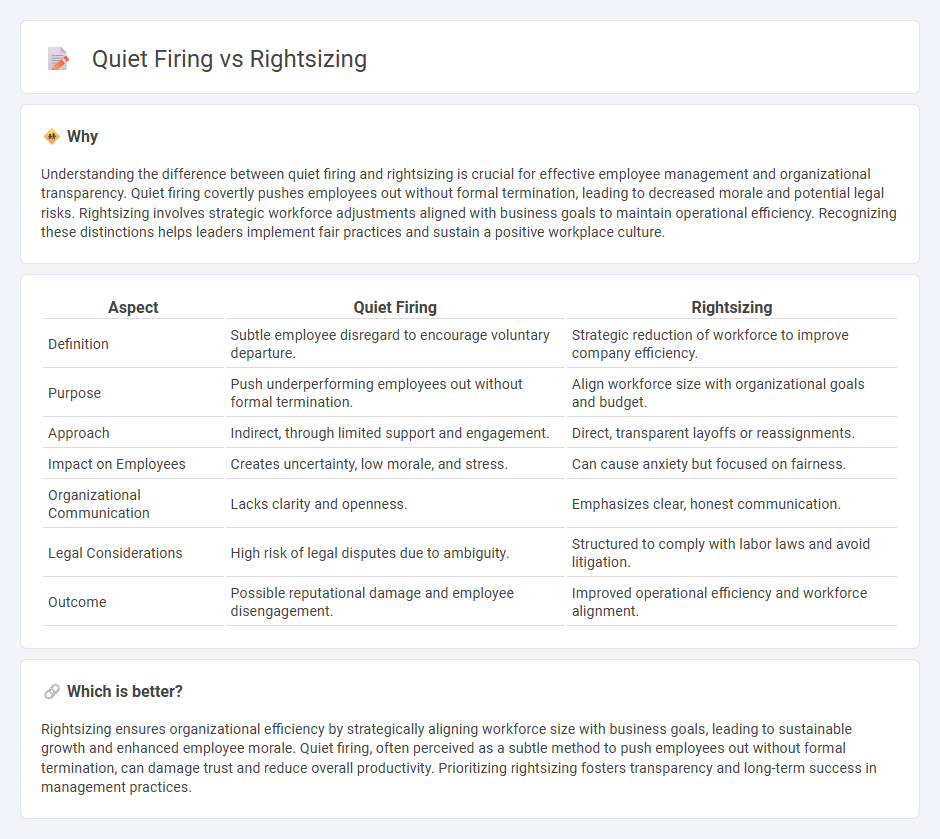
Quiet firing refers to the practice where employers subtly encourage employees to leave without formal termination, often through reduced responsibilities or unfavorable work conditions. Rightsizing involves strategically adjusting workforce size to align with organizational goals, focusing on efficiency and sustainability. Explore the nuances between quiet firing and rightsizing to understand their impact on management and employee relations.
Why it is important
Understanding the difference between quiet firing and rightsizing is crucial for effective employee management and organizational transparency. Quiet firing covertly pushes employees out without formal termination, leading to decreased morale and potential legal risks. Rightsizing involves strategic workforce adjustments aligned with business goals to maintain operational efficiency. Recognizing these distinctions helps leaders implement fair practices and sustain a positive workplace culture.
Comparison Table
| Aspect | Quiet Firing | Rightsizing |
|---|---|---|
| Definition | Subtle employee disregard to encourage voluntary departure. | Strategic reduction of workforce to improve company efficiency. |
| Purpose | Push underperforming employees out without formal termination. | Align workforce size with organizational goals and budget. |
| Approach | Indirect, through limited support and engagement. | Direct, transparent layoffs or reassignments. |
| Impact on Employees | Creates uncertainty, low morale, and stress. | Can cause anxiety but focused on fairness. |
| Organizational Communication | Lacks clarity and openness. | Emphasizes clear, honest communication. |
| Legal Considerations | High risk of legal disputes due to ambiguity. | Structured to comply with labor laws and avoid litigation. |
| Outcome | Possible reputational damage and employee disengagement. | Improved operational efficiency and workforce alignment. |
Which is better?
Rightsizing ensures organizational efficiency by strategically aligning workforce size with business goals, leading to sustainable growth and enhanced employee morale. Quiet firing, often perceived as a subtle method to push employees out without formal termination, can damage trust and reduce overall productivity. Prioritizing rightsizing fosters transparency and long-term success in management practices.
Connection
Quiet firing and rightsizing both impact organizational efficiency by selectively reducing workforce without overt termination processes. Quiet firing involves subtly pushing employees to leave voluntarily, while rightsizing aligns staff levels with strategic business goals through restructuring. Both strategies manage talent costs and performance but differ in transparency and employee experience.
Key Terms
Workforce Optimization
Rightsizing strategically aligns workforce capacity with business needs by adjusting employee numbers through hiring or layoffs to optimize productivity and cost efficiency. Quiet firing involves subtly pushing employees out by reducing responsibilities or opportunities without formal termination, often leading to disengagement and turnover. Explore more insights on effective workforce optimization strategies and best practices.
Employee Engagement
Rightsizing involves strategically adjusting workforce size to enhance organizational efficiency while maintaining employee engagement, whereas quiet firing subtly pressures employees to leave without formal termination. Understanding these approaches is crucial for fostering a transparent work culture that supports staff morale and productivity. Explore deeper insights on how these practices impact employee engagement and corporate health.
Organizational Culture
Rightsizing restructures the workforce to align employee numbers with business needs, promoting a culture of adaptability and efficiency. Quiet firing subtly encourages employee departure through reduced opportunities or support, which can erode trust and morale within organizational culture. Learn more about how these practices impact employee engagement and company values.
Source and External Links
What Is Rightsizing? Plus Pros and Cons - Rightsizing is a strategic approach to managing an organization's workforce for optimal efficiency, involving methods like restructuring, layoffs, and outsourcing.
What Is Rightsizing? - Rightsizing is the process of restructuring a company to meet updated business objectives efficiently, often involving workforce and organizational changes.
The Comprehensive Guide to Rightsizing in Retirement - Rightsizing in retirement involves understanding how you live in your home, decluttering, and moving to a smaller space that is fully utilized.
 dowidth.com
dowidth.com